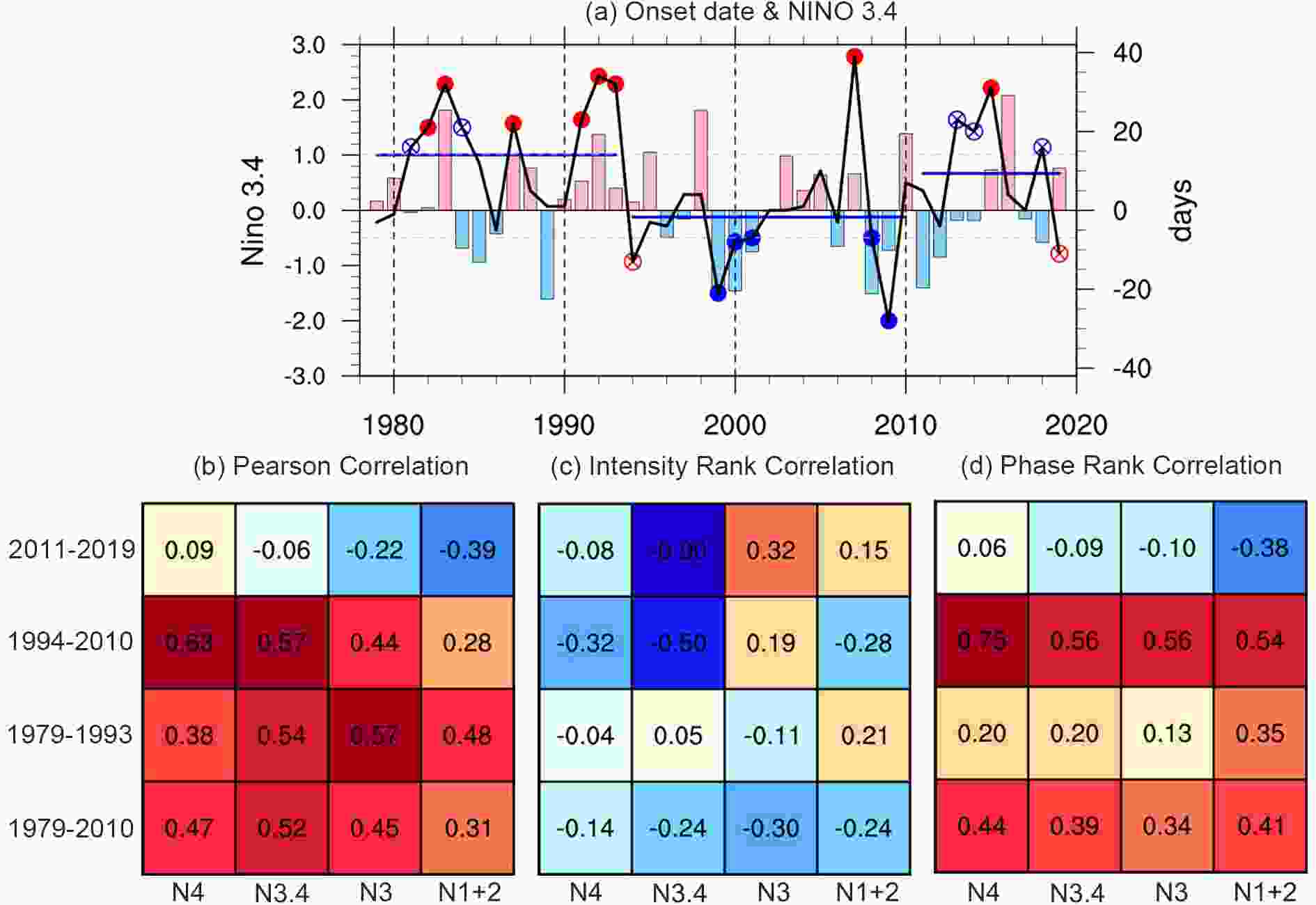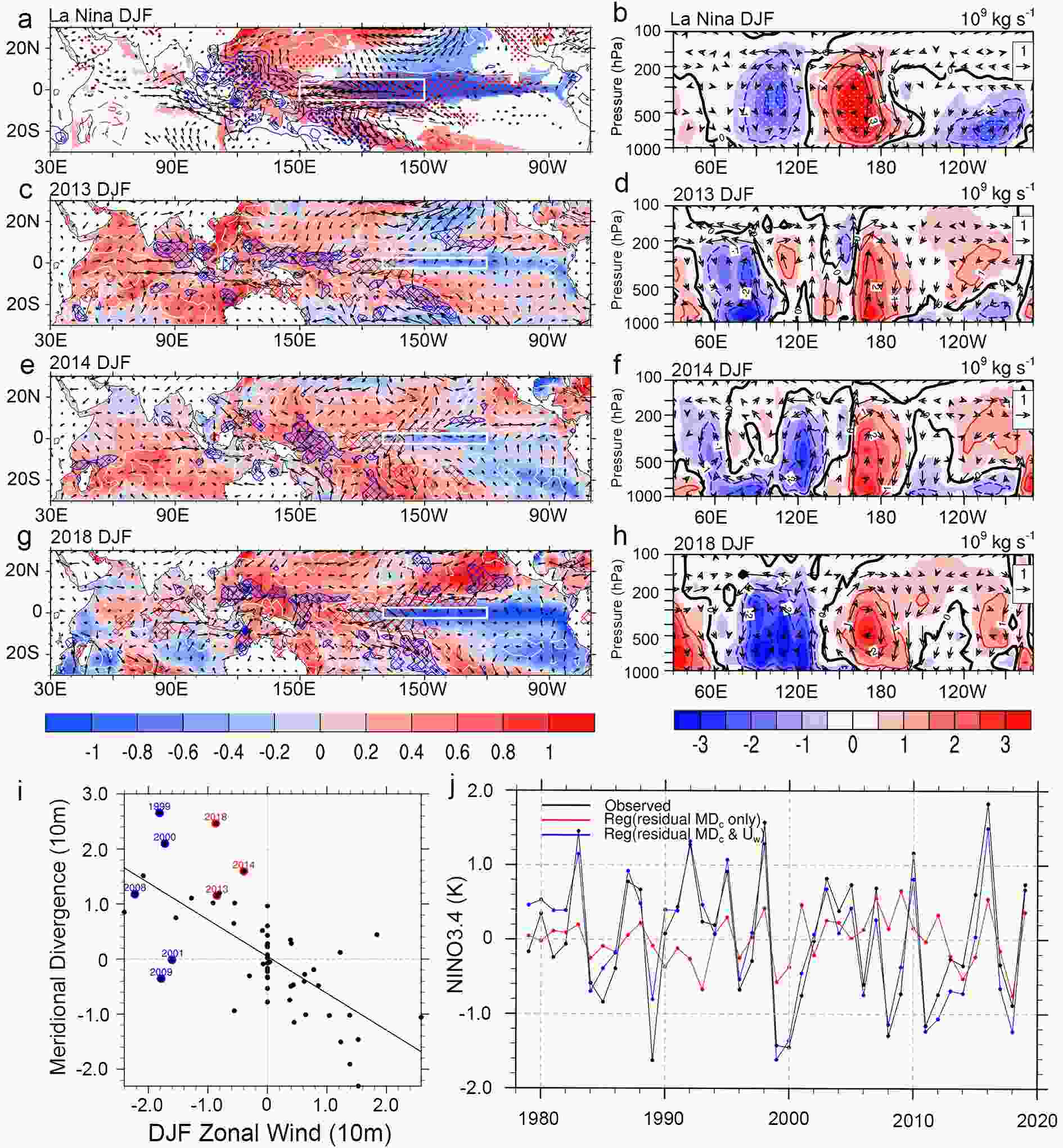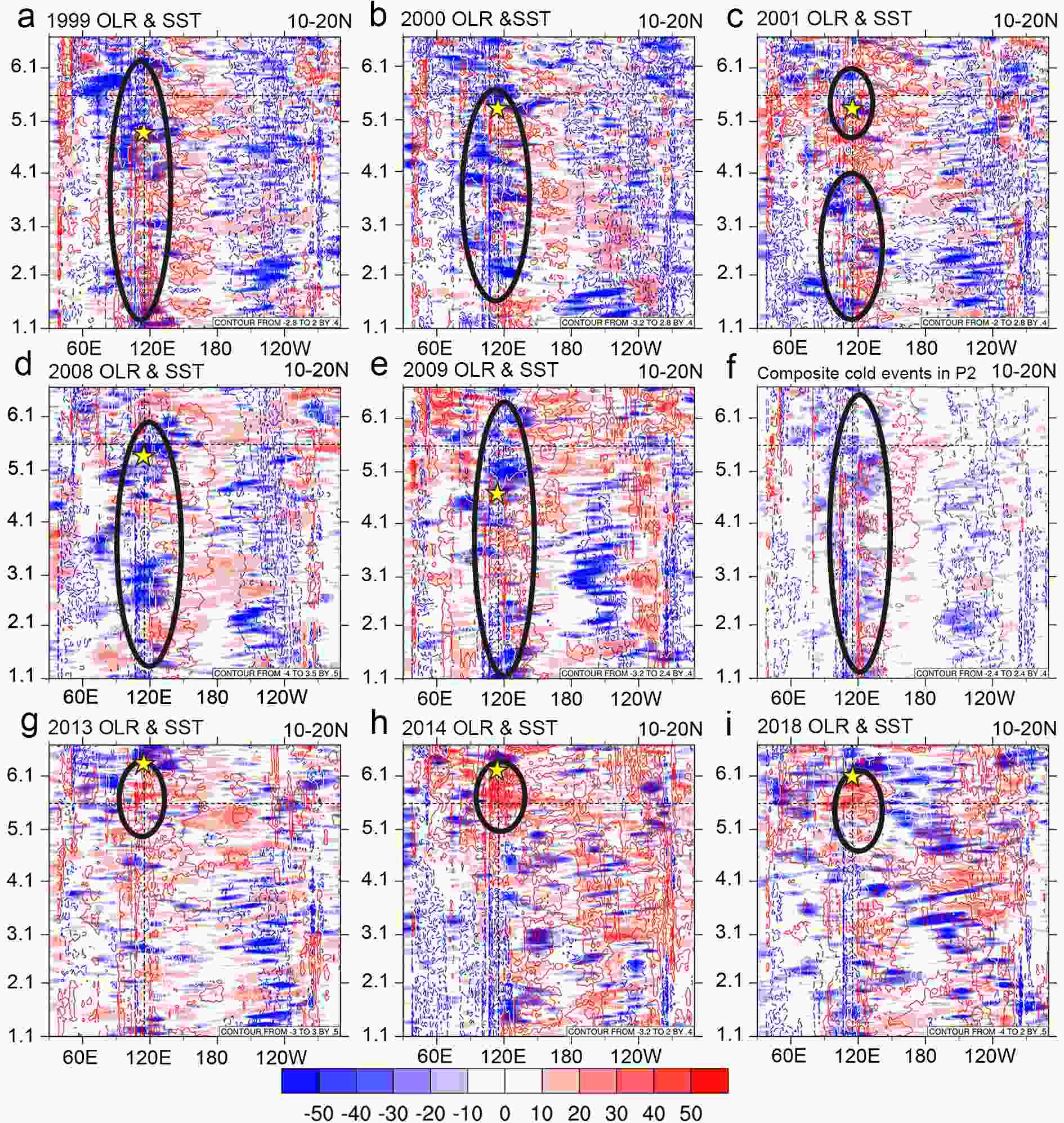HTML
--> --> -->ENSO has been regarded as the most important factor in the seasonal prediction of the SCSSM onset time on the interannual time scale (Zhou and Chan, 2007; Luo et al., 2016; Luo and Lin, 2017; Martin et al., 2019). According to previous understanding, a warm (cold) ENSO event in winter tends to delay (advance) the onset of the SCSSM by strengthening (weakening) the western North Pacific subtropical high (Zhou and Chan, 2007). On the decadal time scale, warming sea surface temperature (SST) in the equatorial western Pacific can cause earlier SCSSM onset by enhancing intraseasonal variability and tropical cyclone activities (Kajikawa and Wang, 2012), as well as the western Pacific warm pool heat content (Feng and Hu, 2014). However, the onset of the SCSSM has been observed to be relatively late in the past decade, even though the observed SST has kept on warming over the equatorial western Pacific (Luo and Lin, 2017), particularly against a La Ni?a-like SST background (Liu and Zhu, 2019).
In this study, we found that the broken relationship between the SCSSM onset and ENSO can be attributed to the disturbance of cold tongue (CT) La Ni?a events. The prevalent CT La Ni?a events along with the Indian?western Pacific warming in the past decade were able to delay the onset of the SCSSM. Therefore, some previous empirical seasonal forecast models based on ENSO SST indices may fail owing to the recently frequent CT La Ni?a events.
We, following Shao et al. (2015), define the SCSSM onset date by considering both the circulation and convection criteria. Also, the SCSSM onset date anomalies are referred to as the departure from the climatological onset date (16 May; reference line in Fig. 1a). The timing of SCSSM onset based on this definition is nearly consistent to the previous work (Shao et al., 2015), especially for the years to be analyzed (Wang et al., 2004; Liu et al., 2016; Liu and Zhu, 2019). Four ENSO indices (Ni?o 3.4, Ni?o 3, Ni?o 4, Ni?o 1+2) are used to assess the relationship of ENSO diversity with SCSSM onset. Besides Pearson correlation, Spearman (Kendall) Rank correlation—namely, intensity (phase) rank correlation—is used to evaluate the intensity (phase) correlation of ENSO with SCSSM onset. The Spearman Rank (intensity rank) correlation is simply the Pearson correlation coefficient computed using the ranks of the data in intensity. Furthermore, Kendall (phase rank) correlation here is calculated by considering the matching relationship of the data pairs in phases, where the Ni?o indices and the SCSSM onset dates are classified into positive, negative and normal (0) categories.
 Figure1. (a) Time series of SCSSM onset date anomalies and the DJF Ni?o3.4 index (bars). The two horizontal dashed lines represent the averaged values for the late and early onset date anomalies respectively. The SCSSM onset dates exceeding the dashed lines are marked by the dots and circles. The red (blue) dots indicate a late (an early) onset with a positive (negative) Ni?o3.4 index in the previous winter, and instead the others with a reverse relationship are marked by the circles. The blue lines illustrate the averaged onset dates for the periods of 1979?94, 1995?2010 and 2011?19. (b?d) Correlation coefficients between four ENSO indices and SCSSM onset date during the three periods. The Pearson correlation, Intensity Rank correlation and Phase Rank correlation are illustrated in (b?d) respectively.
Figure1. (a) Time series of SCSSM onset date anomalies and the DJF Ni?o3.4 index (bars). The two horizontal dashed lines represent the averaged values for the late and early onset date anomalies respectively. The SCSSM onset dates exceeding the dashed lines are marked by the dots and circles. The red (blue) dots indicate a late (an early) onset with a positive (negative) Ni?o3.4 index in the previous winter, and instead the others with a reverse relationship are marked by the circles. The blue lines illustrate the averaged onset dates for the periods of 1979?94, 1995?2010 and 2011?19. (b?d) Correlation coefficients between four ENSO indices and SCSSM onset date during the three periods. The Pearson correlation, Intensity Rank correlation and Phase Rank correlation are illustrated in (b?d) respectively.The Pearson correlation between the SCSSM onset and ENSO indices is a result combining the mutual relationship of the intensities and phases between the two time series. The positive Pearson correlations between the SCSSM onset and ENSO indices during the period before 2010 (Fig. 1b) are mainly contributed by their phase correlation (Fig. 1c), instead of the intensity correlation (Fig. 1d). This implies that the influences of ENSO on SCSSM onset are mainly determined by the spatial pattern of El Ni?o-like or La Ni?a-like SST anomalies (SSTAs) instead of the amplitude of ENSO indices (extreme or moderate). It is noted that the warm phase of ENSO is mostly followed by late SCSSM onset during the whole period of 1979?2019, but the cold phase of ENSO can be followed by either earlier or late onset (Fig. 1a). It has been suggested that the notable positive correlation between ENSO and SCSSM onset during the early-onset period (P2) can be attributed to the frequent La Ni?a events (Liu et al., 2016). However, the three cold events (2013, 2014 and 2018) during P3, corresponding to the negative phase of ENSO, are all followed by late SCSSM onset. This suggests that the broken positive correlation between ENSO and SCSSM onset during P3 is possibly contributed by the negative phase of ENSO in the past decade.
To verify our hypothesis, we investigate five La Ni?a-like events (1999, 2000, 2001, 2008 and 2009) followed by notable early SCSSM onsets for comparison, and try to reveal the distinct impacts of cold ENSO between P2 and P3. Their composite SSTAs in the previous winter (DJF; December?January?February) resemble the canonical La Ni?a pattern (Fig. 2a) along with strengthened pan-tropical Pacific Walker circulation and enhanced convection over the SCS (Fig. 2b). Two opposite anomalous vertical circular circulation centers are located over the west and east of the SCS (Fig. 2b) with strong low-level zonal wind convergence over the SCS (Fig. 2a). The central-eastern Pacific cooling is likely related to the Bjerknes feedback, which emphasizes the role of the zonal wind in air?sea interaction.
 Figure2. (a) DJF SST (shading), 10-m wind (vectors) and precipitation anomalies (contours; blue: positive, red: negative), and (b) zonal mass stream function, pressure velocity (omega × ?50; units: Pa s?1), and zonal divergent wind (units: m s?1) averaged within 5°S?5°N for the composite of La Ni?a events (1999, 2000, 2001, 2008 and 2009). The second, third and fourth rows represent those in 2013, 2014 and 2018 (precipitation anomalies: contours with crossing lines; 2 mm d?1 interval). Only the values for the wind and SST (precipitation) anomalies above the 90% confidence level are shown (marked by dots) in (a). The white boxes in (a) and (c, e, g) represent the areas (5°S?5°N, 150°E?150°W and 2.5°S?2.5°N, 170°W?120°W) that define the
Figure2. (a) DJF SST (shading), 10-m wind (vectors) and precipitation anomalies (contours; blue: positive, red: negative), and (b) zonal mass stream function, pressure velocity (omega × ?50; units: Pa s?1), and zonal divergent wind (units: m s?1) averaged within 5°S?5°N for the composite of La Ni?a events (1999, 2000, 2001, 2008 and 2009). The second, third and fourth rows represent those in 2013, 2014 and 2018 (precipitation anomalies: contours with crossing lines; 2 mm d?1 interval). Only the values for the wind and SST (precipitation) anomalies above the 90% confidence level are shown (marked by dots) in (a). The white boxes in (a) and (c, e, g) represent the areas (5°S?5°N, 150°E?150°W and 2.5°S?2.5°N, 170°W?120°W) that define the 
























Although the three cold events (2013, 2014 and 2018) in P3 share a roughly similar anomalous SST morphology in P2 as the canonical La Ni?a events, the detailed atmospheric circulation structures are quite different (Figs. 2c-h vs. Figs. 2a and b). The cooling areas in the east of the tropical Pacific for the three events are much narrower in the meridional direction (white boxes in Figs. 2c, e and g) along the equator, and their zonal trade wind anomalies around the dateline are much weaker. The equatorial narrow cooling in the three La Ni?a events is closely related to the surface meridional wind divergence instead of the zonal trade wind. In addition, the associated convections surrounding the eastern cooling regions are located in the western Pacific and north and south subtropical Pacific (Figs. 2c, e and g). Compared with the canonical La Ni?a events in Figs. 2a and b, the convections in the recent three cold events are much weaker and located in the east of the SCS. Correspondingly, a strong vertical circular circulation is located to the east of 150°E. Some scattered convections around the SCS also induce several reversed vertical circular circulations, but seem irrelevant to the large-scale Pacific Walker circulation (Figs. 2d, f and h). Considering the common unique features of the three cold events, these La Ni?a-like events along with surface meridional wind divergence and narrow east cooling resembles the so-called CT mode (Zhang et al., 2010; Li et al., 2015; Jiang and Zhu, 2018, 2020)—namely a background mode under recent global warming. Therefore, these cold events in P3 can be named as CT La Ni?a events. However, it is hard to distinguish these CT La Ni?a events from the canonical La Ni?a events based only on the current SST Ni?o indices. Thus, a new index is introduced to depict the CT La Ni?a events.
Considering the surface wind features of CT La Ni?a events, the surface meridional wind divergence



























































































 Figure3. Hovm?ller diagrams for OLR (shading) and SST (contours; red: positive, blue: negative) anomalies averaged within the tropical band (10°?20°N) for composited (f) and individual cases. Panel (f) represents the case composited by (a?e). The horizontal and vertical reference lines represent the climatological SCSSM onset date and the SCS position. The yellow stars indicate the SCSSM onset dates for different years, and the evolutions of convection around SCSSM onset are marked by the black circles.
Figure3. Hovm?ller diagrams for OLR (shading) and SST (contours; red: positive, blue: negative) anomalies averaged within the tropical band (10°?20°N) for composited (f) and individual cases. Panel (f) represents the case composited by (a?e). The horizontal and vertical reference lines represent the climatological SCSSM onset date and the SCS position. The yellow stars indicate the SCSSM onset dates for different years, and the evolutions of convection around SCSSM onset are marked by the black circles.Consistent with the persistence of convection over the SCS, the air?sea structures of the canonical La Ni?a events during P2 also persist from winter to spring (Figs. 4a-c). However, the structures of the CT La Ni?a events change greatly in spring. An evident anomalous anticyclone (marked by the letter “A” in the left-hand column in Fig. 4) in the lower troposphere is centered over the SCS with suppressed convection, which possibly postpones the SCSSM onset. The enhanced convections surrounding the SCS are mainly located over the northern Indian Ocean, Maritime Continent, and western Pacific (150°E?180°), inducing vertical circular circulations influencing the SCSSM onset. For instance, in May 2013, the enhanced convections over the Maritime Continent and northern Indian Ocean induce strong descending motion over the SCS (second row in Fig. 4). Besides the convections over the Maritime Continent and northern Indian Ocean, the enhanced convections over the northern subtropical Pacific also suppress the convections over the SCS in 2018 (last row in Fig. 4).
 Figure4. Similar to Fig. 2 but for (a) SST (shading), 10-m wind (vector) and precipitation (contours; blue: positive, red: negative) anomalies, (b) zonal mass stream function, pressure velocity (omega × ?50; units: Pa s?1), and zonal divergent wind (units: m s?1) averaged within 10°?20°N, and (c) meridional mass stream function, pressure velocity (omega × ?50; units: Pa s?1), and meridional divergent wind (units: m s?1) averaged within 110°?120°N for the composited La Ni?a case in May. The second, third and fourth rows represent those in 2013, 2014 and 2018. The location of the SCS is marked by the black triangle in the last two rows.
Figure4. Similar to Fig. 2 but for (a) SST (shading), 10-m wind (vector) and precipitation (contours; blue: positive, red: negative) anomalies, (b) zonal mass stream function, pressure velocity (omega × ?50; units: Pa s?1), and zonal divergent wind (units: m s?1) averaged within 10°?20°N, and (c) meridional mass stream function, pressure velocity (omega × ?50; units: Pa s?1), and meridional divergent wind (units: m s?1) averaged within 110°?120°N for the composited La Ni?a case in May. The second, third and fourth rows represent those in 2013, 2014 and 2018. The location of the SCS is marked by the black triangle in the last two rows.According to the above analyses, the canonical La Ni?a events in P2 strengthen the pan-tropical Pacific Walker circulation, enhance persisting convection over the SCS, and advance the SCSSM onset, supporting the positive relationship between SCSSM onset and ENSO. In contrast, the CT La Ni?a events in P3 induce a vertical circular circulation over the east of the SCS, but it cannot maintain to spring. The late onset of the SCSSM following the CT La Ni?a years in P3 is mainly postponed by enhanced convections over the northern Indian Ocean, Maritime Continent, and western Pacific surrounding the SCS.
To further verify the impact of CT La Ni?a on late SCSSM onset, we firstly remove the influence of the zonal wind (





 Figure5. (a) The DJF residual
Figure5. (a) The DJF residual 
The warming Indian Ocean?western Pacific and the cooling along the coast of Peru in the CT La Ni?a events during P3 are mainly contributed by their trends under global warming (Fig. 5b). Also, the northern and southern subtropical Pacific are warming significantly via the wind?evaporation?sea surface temperature feedback (Fig. 5a). Considering the seasonal march of the warm pool regions (purple lines in Figs. 5a and c) and the evolution of CT La Ni?a, the convections over the SCS should be suppressed thanks to the surrounding enhanced convections, particularly over the Indian Ocean and the northern subtropical Pacific.
Besides the interannual variation, the warming trend of the Indian Ocean is also significant. Although the Indian Ocean Capacitor effect (Xie et al., 2009) after ENSO can still be detected by the phase-lag relationship of SSTAs between the eastern Pacific and Indian Ocean (Fig. 5e), the SSTA barely cools owing to the rapid warming in the Indian Ocean in the past decade, suggesting an asymmetrical response of the Indian Ocean SSTA to ENSO. For the three CT La Ni?a events during P3, the warming surrounding the SCS could have enhanced convections and postponed the SCSSM onset. Since SCSSM onset can also be triggered by synoptic or intraseasonal activities, the warming SST in the Indian Ocean can enhance convection and atmospheric disturbance and in turn bring greater uncertainties for the seasonal forecasting of SCSSM onset. Following an El Ni?o event, the warming SSTA may become remarkable in the Indian Ocean and result in enhanced convection disturbances to trigger an early onset of the SCSSM. For example, the extreme early SCSSM onset in 2019 was attributed to the intraseasonal oscillation (Hu et al., 2020) and typhon “Fani” (Liu and Zhu, 2020). Liu and Zhu (2020) indicated that the anomalous condensation heating released by the typhon not only shifted the South Asian high northward, but also reinforced the upper-level barotropic trough to the west of the Tibetan Plateau at midlatitudes. This facilitated the early establishment of monsoon convection by intensifying the upper-level pumping over the SCS.
The anomalous SST morphology of CT La Ni?a resembles that of conventional events, but its cooling area is narrowed along the equator with weaker trade winds. We found that the cooling SST of CT La Ni?a events is dominated by the meridional wind divergence in the eastern Pacific, which is distinct from canonical La Ni?a events with strong trade winds. Following a CT La Ni?a in the preceding winter, the suppressed convections over the SCS in May postpone the SCSSM onset, which is mainly due to the enhanced convections over the northern Indian Ocean, western Pacific, and Maritime Continent. It is suggested that both the evolution of CT La Ni?a and the warming SST in the Indian?western Pacific contribute to late SCSSM onset.
CT La Ni?a events dominated by surface meridional wind divergence have been more likely to occur in recent years, but can barely be distinguished from canonical events by the SST ENSO indices alone. Due to the distinct influences of CT La Ni?a events, some known empirical seasonal forecast models based on ENSO SST indices may be challenged. Therefore, besides these SST ENSO indices, it is suggested that additional indices, such as


Acknowledgements. The authors acknowledge the anonymous reviewers’ helpful suggestions, and Dr. Jeremy Cheuk-Hin LEUNG’s polishing. This work was jointly sponsored by the National Key R&D Program (Grant No. 2018YFC1505904), the National Science Natural Foundation of China (Grant No. 41830969) and the Basic Scientific Research and Operation Foundation of the Chinese Academy of Meteorological Sciences (Grant Nos. 2018Z006 and 2018Y003), and the scientific development foundation of CAMS (2020KJ012). This study was also supported by the Jiangsu Collaborative Innovation Center for Climate Change. The HadISST1 dataset was obtained from the Met Office Hadley Centre and can be downloaded from
